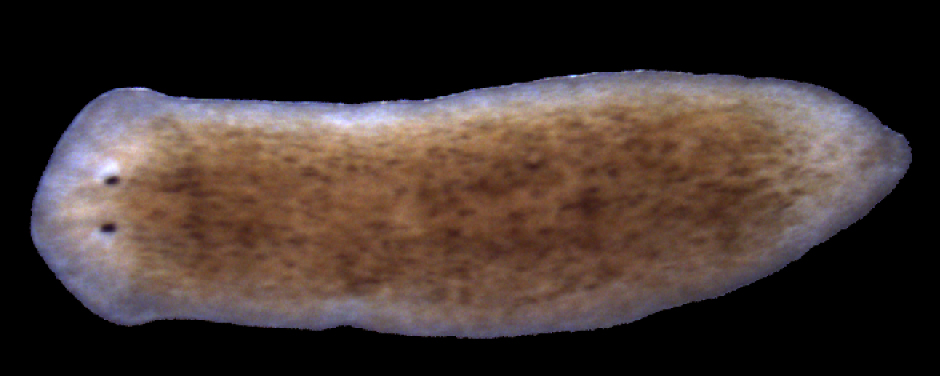
Planarian flatworm. Credit: Tufts University
The brains of simple animals such as flatworms and tadpoles have much in common with the brains of humans, sharing many of the same behavioral pathways and neurotransmitters. So experiments are frequently performed on these animals in order to better understand properties of the human mind such as learning and memory. In a typical experiment, light stimuli are used to train worms to stay in, or avoid, specific parts of the dish or to move at specific rates. Worms inherently prefer the dark, so those that successfully perform the task are rewarded by lowered light levels.
“Modern cognitive science is striving to understand the connection between molecular genetics and the information processing mechanisms that give rise to behavior and thought,” said Michael Levin, Ph.D., Vannevar Bush professor, Biology Department, and director, Allen Discovery Center at Tufts University. “The biomedical aspect of this goal includes the search for drugs that will aid learning and memory and the understanding of various influences on cognition.”
In the past, these studies have been performed by using human researchers to observe the behavior of the animals in the test chamber. But the manual approach of assessing behavior puts significant limits on experimental progress. Only a limited number of animals can be analyzed by hand due to manpower and cost limitations. Manual handling also introduces the potential for the results to be affected by the judgment and errors of the person running the experiment.
To address some of these limitations, the Tufts Center for Regenerative and Developmental Biology partnered with Boston Engineering to develop the first automated learning and testing chamber for analyzing behavior in small animals. Boston Engineering is a product development and engineering firm that designs and builds products as well as custom electronic devices and instrumentation for applications including wireless and wired communications, sensing, and signal processing.
Machine vision was one of the greatest challenges in this automated learning system. The water touching the sides of the dish creates a meniscus that rises and falls. This creates shadows that change over time and are difficult to distinguish from the worms. The application requires a vision system with powerful vision tools that are capable of identifying the location of the worm and is completely self-contained in a compact package so we can easily increase the number of cells. The Cognex In-Sight Micro 1400 was ideal for this application because of its broad toolset and the fact that the entire system is contained in a 30 mm x 30 mm by 60 mm enclosure.
Each experiment is controlled by an algorithm written by Levin’s team and Boston Engineering. First, the position of the worms in their dishes is recorded by the vision camera. Then an action is taken such as turning on a light in one quadrant of the dish with the goal of teaching the animal to swim to the lighted quadrant. Then the position of the worm is again recorded by the vision camera. Based on the position (and second-order quantities like speed, direction of movement, etc.) of the worm, another action might be taken such as rewarding the worm by turning down the lights because it swam to the correct quadrant or turning on a bright light because it did not perform the task properly. These series of measurements and actions can continue until the program reaches a predefined condition (a level of performance indicating that the animal has understood the task to be learned).
“Automating the training and testing process will enable us to make faster progress by running many more experiments on a 24×7 basis instead of just when human experimenters are available; moreover, the quantitative data (impossible to obtain with human observers) will reveal unprecedented insights into the processes of learning and memory,” Levin concluded.
.JPG)
Tufts and Boston Engineering worked together to develop the first automated learning and testing chamber for behavior analysis in small animals. (Credit: Boston Engineering)
NOTE: Recent papers discussing the Tufts Center’s work with the automated learning and testing chamber can be found at:
● http://www.springer.com/-/0/AVSIKWyD2brxj7RS5Mny
● http://jeb.biologists.org/content/early/2013/06/27/jeb.087809
● http://jeb.biologists.org/content/216/6/1031.abstract
Mark Smithers, a founding member of Boston Engineering, leads the company’s strategic development activities. He oversees the project management operation for the business and leads activities for the company’s technology/IP creations. Mark combines his experience as a systems engineer and innovator with business expertise to help guide customers towards commercialization success.




